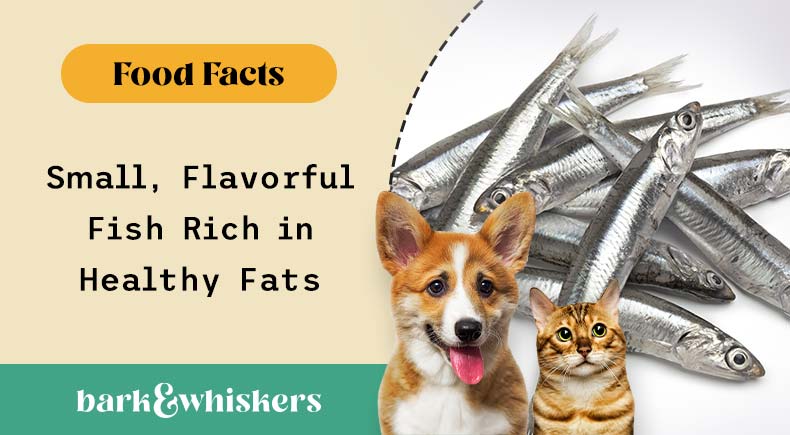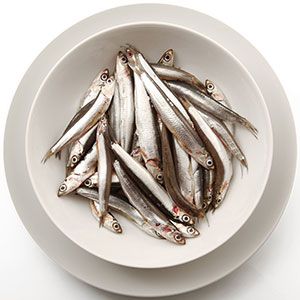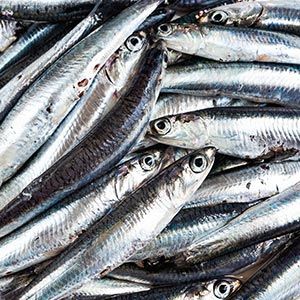Anchovies: Small, Flavorful Fish Rich in Healthy Fats
What this fish lacks in size, it makes up for in flavor and nutrition. With a wealth of healthy fats, vitamins and minerals, it’s a tasty addition to your pet’s repertoire. Find out how to serve it to your pet.

STORY AT-A-GLANCE
- Anchovies are saltwater fish belonging to the Engraulidae family. They’re generally 4 to 10 inches long, with shiny silver-green skin and miniscule scales
- Anchovies are considered one of the top marine-based sources of omega-3 fats, along with other fatty fish like wild salmon and sardines
- Anchovies have a short lifespan, so they do not live long enough to accumulate high amounts of toxins, making them a good choice if you want to supplement your pet’s diet with fish
- Dogs and non-hyperthyroid cats can enjoy anchovies that have not been salt-cured as an ingredient in their DIY treats and a meal topper on their nutritionally complete homemade meal
Editor's Note: This article is a reprint. It was originally published February 27, 2023.
Anchovies may be one of the most polarizing foods around, and you may have encountered them on a pizza or an antipasto salad. Whether you like them or not, there’s no denying that anchovies are rich in flavor, and the same can be said for their nutritional content and health benefits. But can they be fed to cats and dogs as well?
The answer is yes — anchovies can be a tasty, healthy addition to your pet’s nutritionally balanced, species-appropriate diet, and the nutrients that make them beneficial for you can benefit your pet’s health too. Continue reading to find out what these little fish have to offer and how to serve them to your pet.
Where Do Anchovies Live?

Most anchovy species live in temperate seas around the world, moving in large schools along brackish waters like estuaries and bays.1 The major sources of anchovies today are Italy, Spain, Portugal and Turkey.2

What Are Anchovies?
Anchovies are saltwater fish belonging to the Engraulidae family. They’re generally 4 to 10 inches long, with shiny silver-green skin and miniscule scales.3 Despite their diminutive size, the flavor they lend to a dish can make a big difference. Prized in the culinary world for their savory or “umami” flavor, anchovies add depth to various recipes, from pastas and sandwiches to dressings, dips and sauces like Worcestershire and remoulade.4,5
There are more than 140 types of anchovies, but the most common species sold in the U.S. is European anchovies.6 Anchovies are often confused with sardines, and in some places, the terms “sardines” and “anchovies” are used interchangeably.7 However, sardines belong to a different family of fish (Clupeidae), and they’re also larger and lighter in color, with a much milder flavor.8
Anchovies Are a Great Source of Omega-3s
“Omega-3 fats in the form of EPA (eicosapentaenoic acid) and DHA (docosahexaenoic acid) take the spotlight when it comes to the major nutrients found in anchovies.”
Anchovies are considered one of the top marine-based sources of omega-3 fats, along with other fatty fish like wild salmon and sardines.9 EPA and DHA are the preferred forms of omega-3 fatty acids for pets, as they’re the most bioavailable. Studies have demonstrated the many health benefits of these omega-3s to animals, such as helping to:
- Manage inflammation — EPA and DHA exert immunomodulatory and anti-inflammatory properties by inhibiting enzymatic pathways that lead to inflammation.10 They also act as precursors for resolvin, a potent anti-inflammatory compound that can resolve existing inflammation in your pet’s body.11
Since inflammation is at the heart of many chronic diseases, reducing inflammation in your pet’s body can go a long way toward improving their health. In a study published in the journal In Vivo, after increasing EPA and DHA intake in cats and dogs, “therapeutic benefit was found in canine allergic dermatitis, haircoat disorder, keratoconjunctivitis sicca, valvular disease, and canine and feline osteoarthritis.”12
- Improve skin and coat health — In a 2020 study, 24 dogs with poor haircoat were given EPA and DHA for 90 days. The dogs’ hair and skin quality significantly improved, further supporting the potential benefits of using omega-3s to help manage inflammatory skin conditions like atopic dermatitis.13
- Support heart health — Aside from having anti-inflammatory properties, omega-3s also exhibit anti-arrhythmic effects, which may help lower the risk of arrhythmia that’s commonly implicated in heart failure. Omega-3 fats may also help improve the metabolism of energy in heart tissue, as well as endothelial function, heart rate, blood pressure and immune function, according to a study published in the Journal of Small Animal Practice.14
- Promote learning and development in puppies — A study published in the Journal of the American Veterinary Medical Association showed that increasing DHA in weaned puppies helped improve their psychomotor skills, memory and cognition, and immunologic and retinal functions.15
- Protect brain health — A mice study published in the Journal of Neurotrauma found omega-3 fats may help protect brain health by reducing oxidative damage and increasing levels of brain-derived neurotrophic factor (BDNF), a protein that plays a key role in learning and memory.16
Did You Know?

The term “anchovy” comes from the Portuguese word “anchova,” which means “small fish.”17
Selenium Provides Bodywide Benefits
Selenium is an essential trace element that plays important roles in thyroid metabolism, DNA synthesis, antioxidant systems, immune response and reproductive health. One of its most important actions is its ability to promote the production of glutathione, which is the “master antioxidant” in your pet’s body, as well as yours.18,19 Seafoods are listed as one of the best sources of this mineral, and that includes anchovies,20 which contain 36.5 micrograms of selenium per 100-gram serving.21
Other Vitamins and Minerals in Anchovies
In addition to omega-3s and selenium, anchovies are a good source of niacin (vitamin B3), iron, calcium and zinc, according to a study published in the journal Foods.22 These nutrients all contribute to your pet’s optimal health. For instance, niacin is important for energy metabolism, digestion, skin health, DNA repair and nervous system function,23 while calcium is critical for animals’ growth and development, and for maintaining healthy bones and muscles.24,25
Zinc is “an essential trace element, required for enzymatic, structural, and regulatory functions.”26 In terms of iron, this mineral plays a role in red blood cell and hemoglobin production, energy metabolism, enzymatic functions and oxygen transport throughout the body.27,28
Is Toxin Contamination a Concern in Anchovies?
Toxin accumulation in fish is a real and serious concern to consider before feeding fish — as a food or treat — to your dog or cat. Unfortunately, many types of seafood are contaminated with mercury as well as agricultural chemicals like dioxins, pesticides and polychlorinated biphenyls (PCBs).
According to the Environmental Defense Fund, there are several ways in which toxins accumulate in fish. The process starts when industrial and agricultural waste ends up in oceans or is washed away by rainfall into streams and rivers that eventually end up in large bodies of water. These toxins are absorbed by the smallest ocean plants and animals at the low end of the food chain.29
As larger ocean dwellers come along and consume these contaminated plants and prey, the toxins accumulate and become more concentrated in the bodies of the bigger fish. For instance, tuna is a fish you should avoid feeding your pet, as it’s loaded with mercury and other toxic compounds, despite many commercial canned pet foods using it as the primary protein source. For this reason, I don’t generally recommend feeding a base diet of fish protein to dogs or cats, unless you’re choosing specific nontoxic fish and creating a nutritionally complete homemade diet.
With that said, anchovies have a short lifespan, so they do not live long enough to accumulate high amounts of toxins, making them a good choice if you want to supplement your pet’s diet with fish. According to a study published in Food and Chemical Toxicology, the traces of metals and mercury found in anchovies are well below all safety limits, so toxicity is unlikely to appear.30
Are Anchovies Sustainable?

The fishing methods used to catch anchovies have little impact on the environment.31 However, whether anchovies are sustainable or not depends more on where they come from. Because they play a crucial role at the bottom of the food chain, experts are concerned that overfishing in certain areas can cause problems down the line for the rest of the food web.
Case in point, the anchovy population around the Peruvian coast and Southeast Pacific has plummeted due to overfishing, and fishing bans on anchovies were previously enforced around these areas to replenish populations.32,33
To make sure you’re serving sustainable fish to your family, including your pets, choose anchovies from the Northeast Atlantic instead and, as much as possible, buy from sources that are certified sustainable by the Marine Stewardship Council (MSC) or other similar organizations.34
How to Choose and Serve Anchovies to Your Pets
Besides buying your anchovies from certified sustainable sources, make sure you’re also buying fresh fish by giving them a sniff — anchovies have an extremely bad smell when they start to spoil. As with other fish, having bright eyes is also a good indication that they’re fresh.35 If you buy them fresh, you can serve them lightly cooked or offer them raw after freezing them at -4 degrees F (-15 degrees C) for seven days.36
If you can’t find fresh anchovies locally, try the freezer section of your nearby supermarket. You can also buy canned anchovies, just make sure they’re packed in water. You may opt for anchovies packed in olive oil as well if your pet has no issues digesting healthy fats.
Avoid anchovies packed in salt, brine, soy or other oils. Salt-cured anchovies are one of the most popular varieties sold in grocery stores but are not appropriate for pets, as the sodium content is too high. Always read labels carefully to make sure what you’re buying doesn’t contain ingredients that can potentially harm your pet. Uncured anchovies are the healthiest, but if you can only find canned anchovies, opt for anchovies packed in water or olive oil (not soybean oil).
Another important caveat about anchovies is that they’re high in iodine.37 While iodine-rich foods may benefit dogs that are prone to hypothyroidism, they can have the opposite effect on cats. Cats are prone to hyperthyroidism, so they need little iodine from their food — another reason why I don’t recommend feeding a fish-based diet to pets.
With that said, dogs and non-hyperthyroid cats can enjoy anchovies as an ingredient in their DIY treats or a meal topper on their nutritionally balanced homemade meal. When used as a treat, keep in mind that all healthy “extras” should make up less than 10% of your pet’s daily caloric intake.
Sources and References
- 1,3 Brittanica, Anchovies
- 2 FAO, Anchovy
- 4 Huffpost, April 22, 2022
- 5 Serious Eats, August 10, 2018
- 6 Environmental Defense Fund, Anchovy
- 7 The Spruce Eats, January 19, 2023
- 8 Food Network, November 29, 2022
- 9 Biomed Res Int. 2022 Aug 5;2022:3661866
- 10,12 In Vivo. 2021 May-Jun; 35(3): 1419–1436
- 11 Prostaglandins Other Lipid Mediat. 2012 Mar;97(3-4):73-82
- 13 Prostaglandins Leukot Essent Fatty Acids. 2020 Aug;159:102140
- 14 J Small Anim Pract. 2010 Sep;51(9):462-70
- 15 J Am Vet Med Assoc. 2012 Sep 1;241(5):583-94
- 16 Journal of Neurotrauma 21 Oct 2004 Vol. 21, No. 10
- 17 Vocabulary, Anchovy
- 18 Journal of Animal Science and Biotechnology volume 13, Article number: 58 (2022)
- 19 Small Ruminant Research. Volume 89, Issues 2–3, April 2010, Pages 185-192
- 20,22,37 Foods. 2020 Oct 21;9(10):1516
- 21 USDA FoodData Central, Fish, anchovy, european, raw
- 23 Harvard School of Public Health, Niacin – Vitamin B3
- 24 Tierarztl Prax Ausg K Kleintiere Heimtiere. 2012 Apr 24;40(2):135-9
- 25 Vet Clin North Am Small Anim Pract. 2021 May;51(3):623-634
- 26 Animals (Basel). 2021 Apr; 11(4): 978
- 27 Wag Walking, Iron for Dogs
- 28 Frontiers in Veterinary Science, The Role of Iron in Energy Metabolism in Animals
- 29 EDF, “Common questions about contaminants in seafood”
- 30 Food Chem Toxicol. 2019 Jan;123:113-124
- 31 The New York Times, Sept. 30, 2019
- 32 Tridge, January 29, 2021
- 33 Oceana, April 2, 2020
- 34 The Spruce Eats, January 3, 2023
- 35 The Spruce Eats, December 21, 2022
- 36 FDA, Fish and Fishery Products Hazards and Controls Guidance











